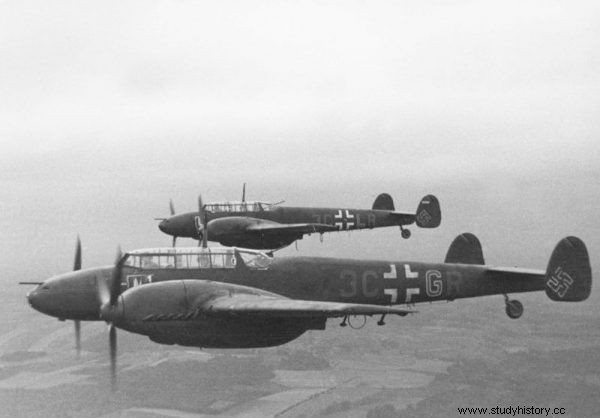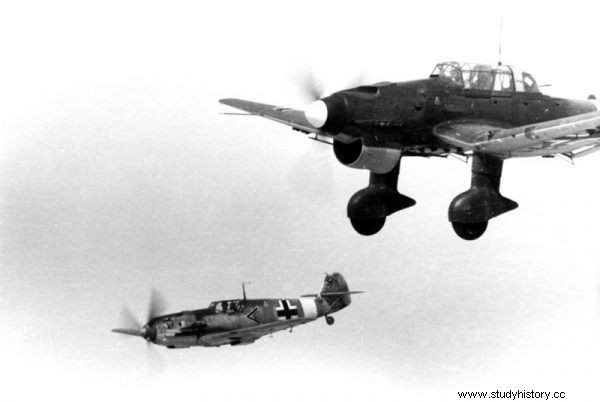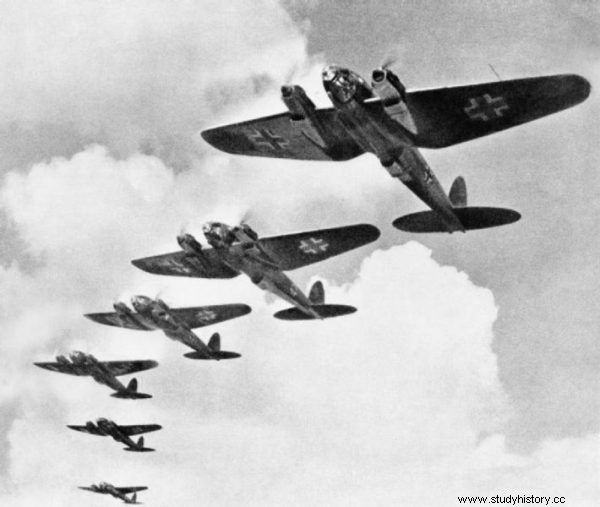When I arrived at the squadron, the Battle of Britain was in full swing. However, parts of the west of England were not in the zone of intense air operations. From time to time, the Luftwaffe made raids on Bristol (aviation industry), Plymouth (navy base) and Portland (submarine base).
On the second day after check-in - this is August 19 - I was instructed to see the area from the air. The next day I was on my normal duty. Two days later, I took off in the wrench on the alarm. The command post changed courses, announced the enemy, but we saw nothing and landed.
The squadron commander assigned me to his key and I always flew with him as No. 2 ever since. I heard a lot of radio conversations - both from the ground and my commander's replies - but basically, except for a single word, I didn't understand anything. >
First encounter
In the afternoon we took off in two divisions. My squadron as leader. We were directed to Portland to patrol the area. We were about 6,000 feet. At one point I noticed that a huge number of planes were flying towards us from the south, about 50–60; these were He 111 and Do 17 bombers, and the rest, about the same, are a cover consisting of the Me 110.

The article is an excerpt from the book My sky-skies. Memoirs of the 302 Squadron commander , which has just been released on the market on the occasion of the 80th anniversary of the Battle of Britain. The daring memories of Marian Duryasz are a real treat for fans of World War II history.
That day our squadron was led by the commander of my squadron, Capt. Sing. I flew as No. 2, and my colleague Belgian (I don't remember my name) as No. 3. The commander began to take the attack position. At the same time, after spotting our planes, the Messerschmitts formed the so-called carousel to prevent us from attacking. Now our commander had to wait for the right moment to attack. As soon as there was a larger break in the enemy machinery circle, the commander gave the signal to attack and our entire squadron descended in order to break the circle constituting a formidable defensive formation.
As the Me 110 were doing the carousel in threes, so threes we attacked three. The commander targeted their leader, I targeted the right one, and the Belgian the left one. Since we had a height advantage, we got very close to our goals. Once the enemy machine was at just the right distance, I took aim and squeezed the trigger.
At the time of interrupting the first or second series, I noticed that the commander had stopped the attack, turned the plane over on its back and went down vertically. I looked around and saw on the right three Me 110s breathing fire 100-150 m away, roughly three-quarters in the rear, and streaks of passing bullets next to the cabin . I immediately kicked the orc and followed the commander.
Trapped
As I was equalizing, I saw that the Belgian plane was on fire and there was smoke trailing behind its plane. The Belgian did not notice and paid for it with his life. The rest of the squadron did not follow us as they noticed what was happening. I had scarcely moved the machine out and started looking for Cpt. Sing when I saw the luminous streaks of bullets again next to the cabin. While dodging, I noticed that I was being attacked by four or five Me 109s that I had never seen before. They most likely came at the time of our attack or were much higher.
So I found myself in dire straits because they were attacking one after the other. Many thoughts skip at such moments, but one, as it turned out, was salutary. I was reminded of what the instructor said that the Me 109 is worse in the right corner than the Hurricane. So I quickly made a tight right turn and tried to get away from the enemy planes as quickly as possible. Below, about two or three thousand meters, I noticed a huge cloud. Get to her as soon as possible - that was all I could dream of at any given moment. Even though I hit full throttle and the engine roared at full speed, it felt like I was still just as far away from the cloud.

Messerschmitt Bf 110C1. Illustrative photo
I knew they were behind me, that they would shoot. And finally, the first cracks and blows, as if someone were throwing stones at the plane. They hit. Was it just a plane or I got hit too, but I just don't feel it? But so far nothing has changed. The cloud is still far away, and I have the impression that the distance of the Germans from me is getting smaller. Again, the feeling as if someone had thrown the plane with a hail of stones. Finally, I fell into the coveted cloud. I leveled the plane and headed north. I was recovering slowly, but I was still afraid of what would happen when the cloud was over. As the seconds went by, I calmed down and started checking systematically about the situation. First, I found myself alive. Further, I'm not hurt. The engine is also running normally, the instrument readings are normal
and the plane responds to the controls correctly.
After leaving the cloud, I did not notice any planes, but the observation of the ground allowed me to quickly find out where I am, and thus find the direction to the airport.
After landing, we found the plane had 8 or 9 holes in the rear fuselage and in the control planes. I went through the first baptism a bit too hard - despite the fact that everything ended happily. It was a bit too emotional for the first time.
Painful losses
In this flight, five planes did not return from our squadron, and three from 87. In our 213 Squadron, two pilots died:a Belgian and a sergeant unknown to me. In addition, the commander of our B squadron, Capt. Strickland (an extremely combat pilot) and a lieutenant who jumped from a burning plane (burned) and was rushed to the hospital. Another lieutenant from our squadron was forced to land in the field. So out of the twelve planes, only seven returned.
The successes, on the other hand, were very slim. Only two German planes shot down (see Strickland and deputy commander of our squadron). But it seems to me that the plane shot by the fallen Belgian did not make it to France either. I was awarded damage to an enemy plane, even though I did not make any claims. The pilots who attacked in the following keys stated that they saw the stalled engine and the descent of the plane I was shooting at. I couldn't notice it. This Belgian lieutenant was extremely nice - I felt very sorry that he was killed. It was said that he had orphaned his wife and son in Belgium. As the fight was taking place by the canal, the bodies were not even found as they went into the water.
Two or three days later, Ju 88 appeared near Exeter at an altitude of 200-300 m. Anti-aircraft artillery opened fire. My key was on standby at once. I jumped out of the barrack, got to the plane and took off first before the others. I was racing at full throttle towards the sea. After a while I saw him. I was coming very slowly. When I was 1-1.5 km from it, it increased its altitude and entered the clouds. We returned to base.

Bf 109E and Ju 87B in 1941. Illustrative photo
In the first days of September, the entire squadron was plunged into the after-dinner nap, when a sudden roar and lumps of dirt falling on the roof of the barrack woke us up. We didn't know what was happening. We rushed to the exit. We only heard the roar of the engines and saw two Me 110s pulling towards the clouds. They were bombarding our pilots' cabin and the planes around it. The bombs literally fell 6–7 m from our barrack - but both us and the planes were fine. This is due to the local border balks, on which fences are made of stones overgrown with blackberries and thick thorns. It was this fence that shielded us from blows and blows.
For London
On September 10, our squadron was moved to Tangmere airfield, located about 15 km east of Southampton, to replace the decimated 601 Squadron, which had been in intense action since the beginning of the Battle of Britain. Two Poles fought in this squadron:Lieutenant Topolnicki and Lieutenant Jankiewicz (my classmates). A few days ago, Lieutenant Topolnicki was wounded and was in the hospital. I saw Jankiewicz only briefly, because on our arrival their squadron was departing to Exeter.
London was within our reach because we were about 100 km away from it. At this time, the Battle of Britain was in its most intense phase. Hundreds of German planes were flying over the south of England every day, which was opposed by about two hundred fighter pilots. I will not describe the entire course of the battle, because a lot has been written about it, and it would only be a repetition of already well-known historical facts. Rather, I will try to highlight how it was seen and experienced by the people of one of the air garrisons.
Three fighter squadrons were stationed at the Tangmere airport at that time. This garrison belonged to those closest to the enemy. It was about five kilometers from the seashore - a little to the side of the main Luftwaffe air strikes. Thus, the units stationed at Tangmere were among those that fought the enemy's attacks in the first place. Normally, the strikes of these squadrons were directed against a force ten times greater.
The organization of air defense during the Battle of Britain was based on the introduction of fighters into action. Well, the southernmost units were intended to defeat the enemy - it was the most difficult task and therefore suffered the most losses. Then another wave was introduced, the purpose of which was to complete the destruction and prevent the enemy from completing the task. Then the third wave entered the fight, the task of which was the final collapse of the enemy and pursuit. These fighters were in the best position and most successful.

Heinkel He 111 bombers over London during the Battle of Britain
As is generally known, the British Isles air defense at that time had a well-organized detection (radar) and notification network.
I have wondered more than once - without knowing about the above structures - why the English have such accurate information about the upcoming air raids.
I thought this data came from a perfectly organized intelligence network. I asked British colleagues about it many times, who confirmed my ignorance. I was simply dazzled by such efficient intelligence activity, which increased my respect for him even more. But I soon found out that data on German air raids come from completely different sources.
The data from the detection network was sent to the group analysis center (air defense region), from there to the group command post (SD) and sector SD (group area was divided into a number of sectors) where three divisions were normally stationed. It was SD Tangmere that was the sector's command post.
In order to determine the location of their own fighters, fighter planes were equipped with automatic devices that turned on the transmitter for 15 seconds per minute, to which three direction stations were tracking and the obtained bearings were transmitted to the SD sector. In our squadron, I - as the No. 2 commander - was the one who turned on the machine. It is understandable that I didn't hear anything for 15 seconds, but it didn't matter to me, because I didn't understand much anyway. In addition, at that time it was very convenient for me, because the planes still had shortwave radios, which required constant regulation of the reception. But at the end of September, the planes were equipped with four-channel ultra-shortwave stations and a "my-enemy" device. At that moment, the conditions for using the radio completely changed.

The article is an excerpt from the book My sky-skies. Memoirs of the 302 Squadron commander , which has just been released on the market on the occasion of the 80th anniversary of the Battle of Britain. The daring memories of Marian Duryasz are a real treat for fans of World War II history.
On the SD of the sector there was a large horizontally arranged board on which the air situation was marked. According to the situational data, their own fighters were commanded. With the arrival of our squadron in Tangmere, we immediately entered a whirlwind of intense activities. The squadrons did not have any spare pilots at all, so that some of them were on duty from morning to night. The upcoming additions to the pilots were sufficient to the necessary minimum. The situation with airplanes was better. Almost always a squadron had two or three in direct reserve. As soon as the losses were incurred, the squadron was replenished with planes in a few hours. It was worse with the pilots.
Source:
The article is an excerpt from the book My sky-skies. Memoirs of the 302 Squadron commander , which has just been released on the market on the occasion of the 80th anniversary of the Battle of Britain. The daring memories of Marian Duryasz are a real treat for fans of World War II history.
